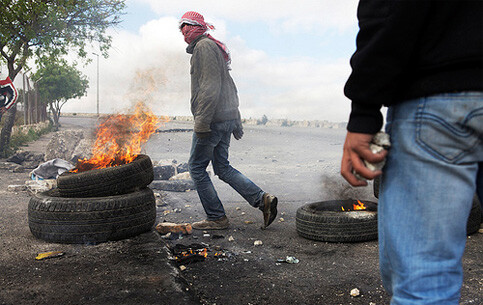The Electronic Intifada 18 March 2010

Young Palestinians hurl stones and burn tires during clashes with Israeli police in Esawiyyah, East Jerusalem, 16 March 2010. (Anne Paq/Activestills.org)
QALANDIA, occupied West Bank (IPS) - On Tuesday tens of hundreds of Palestinians of all political persuasions took to the streets, alleys and sidewalks as widespread rioting and protests spread across occupied East Jerusalem, the rest of the West Bank, Gaza and into Israel proper.
The mini intifada, or uprising, followed the Islamist movement Hamas calling for a “Day of Rage” to protest Israel’s continued Judaization of East Jerusalem and what Palestinians see as an attempt to take over Islamic holy sites.
The numbers rioting were kept relatively low by Israeli military roadblocks and a closure imposed on the West Bank to prevent Palestinians from reaching Jerusalem.
More than 100 Palestinians were wounded, 16 of them suffering broken bones and stomach and eye injuries, and about 80 arrested as the clashes and confrontations with Israeli security forces spread. A number of Israeli soldiers and police were also injured.
On Wednesday thousands of Israeli security forces remained on high alert as further riots were predicted.
Palestinian security forces were also placed on high alert amidst fears that protests could spread to Israeli checkpoints and settlements in the West Bank and further inflame an already volatile situation.
“We will be back tomorrow after school. This is not the end. We are going to come here every day and continue the protests for weeks and months,” one of the protestors told IPS.
“This is just the beginning. This is going to be an ongoing campaign against the Israeli occupation and the desecration of our holy sites,” Nasser Edwan (name changed), a local youth leader, told IPS.
At the Qalandiya refugee camp and checkpoint, situated between Jerusalem and Ramallah, hundreds of school boys and young men, continually approached the Israeli checkpoint in waves, hurling stones and bottles.
Elsewhere Molotov cocktails were thrown, garbage containers set alight and one Israeli policeman was shot by a Palestinian assailant.
The Israeli military tried to disperse the rioters with rubber-coated metal bullets and teargas. But just as soon as the protestors were driven back they would advance again on the checkpoint. Scores were injured and a number arrested.
Generally protests here have a set formula with both sides following unspoken rules. Hitherto clashes in various West Bank villages and in East Jerusalem normally last a few hours after which both sides — the Israeli soldiers and the Palestinian protestors — tire and return to “base.”
Previous protests at Qalandiya witnessed by IPS generally dissipated after several hours.
However, Tuesday’s violence raged from early in the morning to well into the night. Similar scenarios unfolded in various locations of occupied East Jerusalem and the rest of the West Bank while thousands of Palestinians in Gaza took to the streets.
There has been a palpable atmosphere of suppressed anger amongst Palestinians in occupied East Jerusalem and the rest of the West Bank for the last few weeks due to Israel’s accelerated Judaization of East Jerusalem.
Tensions were exacerbated on Monday with the inauguration of a Jewish synagogue on a site where a mosque used to be in the Jewish quarter of Jerusalem’s Old City.
Attempts by Jewish extremists to enter the al-Aqsa Mosque, Islam’s third holiest shrine have also fueled Palestinian anger. These extremists have stated that they would like to build the third Jewish Temple on al-Aqsa’s remains.
The importance and significance of al-Aqsa even to moderate and secular Muslims is unappreciated in many Western quarters.
“I have only two sons and I love them dearly but I’m prepared to sacrifice both of them for al-Aqsa,” one IPS source, a secular and previously senior activist of the secular Fatah movement in Jerusalem’s Old City, said.
“When there were riots several weeks ago, I phoned my sons and told them to close our tourist shop and go to the mosque to defend it from the settlers. Do you think it is easy to lose my sons? Al-Aqsa is a red line which nobody must cross,” he told IPS.
This is the reasoning behind the common ground found by the leadership of both Palestinian political factions, Hamas and Fatah, as they called for their respective followers to take to the streets.
Senior members of the Palestine Liberation Organization, affiliated with Fatah, met in the Ambassador Hotel in occupied East Jerusalem a couple of days ago before appealing to Palestinians to take action.
The leadership also met in the same hotel and called for defensive measures prior to the outbreak of the second Palestinian intifada in 2000 when then Israeli premier Ariel Sharon made his provocative visit to the al-Aqsa mosque despite being warned against doing so by Israeli security.
Furthermore, the Fatah-affiliated al-Aqsa Martyrs’ Brigades have called for the Palestinian Authority to allow them to rearm and defend al-Aqsa from the Israelis.
Israel recently pardoned over 70 former al-Aqsa members on the condition they give up their weapons and cease resistance. Hundreds of others have been pardoned by Israel over the last few years.
Hamas leader Ahmed Bahar called for a renewal of armed attacks against Israel and urged Arab states to support the resistance.
Meanwhile, Israeli settlers have warned that they will retaliate against any Palestinian rioting by mounting counter-riots.
They have also warned that they will attack “Arabs and their property” if they are prevented in the future from entering the al-Aqsa compound.
While a full-scale intifada does not appear imminent, further large-scale unrest appears highly possible with some Israeli analysts calling Tuesday’s events an “intifada-light.”
All rights reserved, IPS - Inter Press Service (2010). Total or partial publication, retransmission or sale forbidden.





